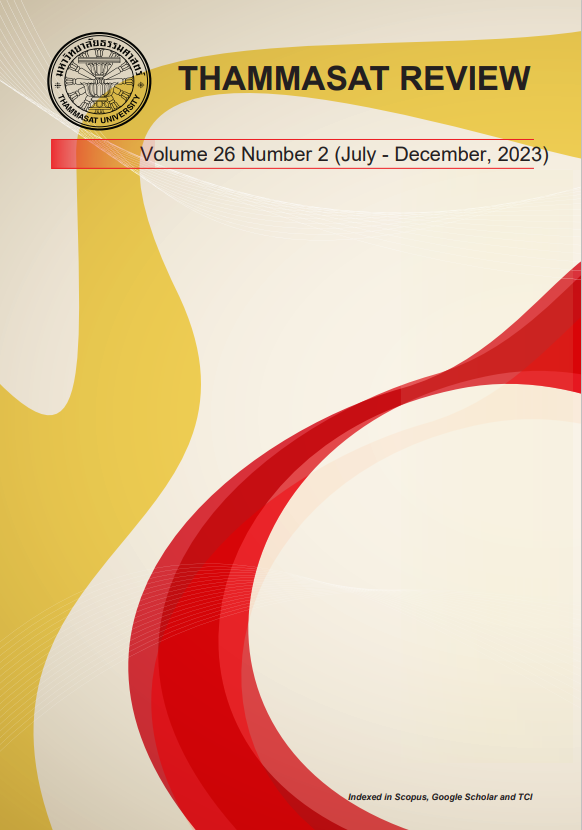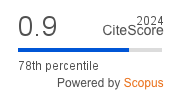Discovering the Untapped Objectives of Cultural Diplomacy
Keywords:
Cultural diplomacy objective, Indonesian Arts and Culture Scholarship, Soft power, Public diplomacy, Student mobility programAbstract
Many countries have utilized cultural diplomacy throughout history to approach foreign audiences, attract them, and achieve the implementing government's goals. However, cultural diplomacy is still often overlooked and underestimated despite its long-standing use. As a result, the scientific development of cultural diplomacy has been impacted, making it less advanced than other sciences of similar age. Despite these challenges, there are still opportunities to contribute to cultural diplomacy today. Our research aims to take advantage of these opportunities by analyzing testimonials from 52 Indonesian Arts and Culture Scholarship alumni we found in a book published by the Indonesian Foreign Affairs Department to identify the objectives of cultural diplomacy. We conducted a study on the alumni testimonials of student mobility programs and identified 292 citations, which we coded and grouped into ten themes. Based on these themes, we developed ten cultural diplomacy objectives. We compared our findings with the objectives suggested by experts and discovered that six of our objectives align with theirs. However, the remaining four objectives are unique and have the potential to make significant contributions to the country if utilized effectively. It is fascinating to see how pure arts and cultural activities can evoke strong emotions, demonstrating the potential of soft power. Well-implemented cultural diplomacy can help achieve the implementing government's objectives and contribute to the country's growth and development.
References
Academy for Cultural Diplomacy. (2017). Art as Cultural Diplomacy. Academy for Cultural Diplomacy. 2017. https://www.culturaldiplomacy.org/academy/index.php?en_acd_about.
Admin Fisip. (2019). Pembukaan Program Beasiswa Seni Dan Budaya Indonesia (BSBI) 2019 Secara Resmi Oleh Rektor UPNVY. Fakultas ILmu Sosial Dan Ilmu Politik UPN Veteran Yogyakarta. 2019. https://www.fisip.upnyk.ac.id/berita/pembukaan-program-beasiswa-seni-dan-budaya-indonesia-bsbi-2019--secara-resmi-oleh-rektor-upnvy.
Admin Kemlu. (2022). Beasiswa Seni Dan Budaya Indonesia (BSBI) Kembali Dibuka! Kementerian Luar Negeri Indonesia. 2022. https://kemlu.go.id/suva/id/news/18549/ beasiswa-seni-dan-budaya-indonesia-bsbi-kembali-dibuka.
Adrian, A. (2019). Soft Power, Culture and Modernity: Responses to Bollywood Films in Thailand and the Philippines. International Communication Gazette, 81(5), 470–89. https://doi.org/10.1177/1748048518802234.
Ang, I., Isar, Y. R., & Mar, P. (2015). “Cultural Diplomacy: Beyond the National Interest?” International Journal of Cultural Policy, 21(4), 365–81. https://doi.org/10.1080/10286 632.2015.1042474.
Appel, R., Irony, A., Schmerz, S., & Ziv, A. (2008). Cultural diplomacy: An important but neglected tool in promoting Israel’s public image. The Interdisciplinary Center Herzliya Lauder School of Government, Diplomacy and Strategy, 1-65.Athique, Adrian. 2019. Soft Power, Culture and Modernity: Responses to Bollywood Films in Thailand and the Philippines. International Communication Gazette, 81(5), 470–89. https://doi.org/10. 1177/1748048518802234.
Ayhan, K. Jun., & Snow, N. (2019). The Boundaries of Public Diplomacy and Nonstate Actors: A Taxonomy of Perspectives. International Studies Perspectives, 20(1), 63–83. https://doi.org/10.1093/isp/eky010.
Bakalov, I. (2019). Whither Soft Power: Divisions, Milestones, and Prospects of a Research Programme in the Making. Journal of Political Power, 12(1), 129-151. https://doi.org/10. 1080/2158379X.2019.1573613
Becard, D. S. R., & Filho, P. M. (2019). Chinese Cultural Diplomacy: Instruments in China’s Strategy for International Insertion in the 21st Century. Revista Brasileira de Politica Internacional, 62(1). https://doi.org/10.1590/0034-7329201900105.
Boutabssil, F. (2021). Evaluation of the Impact of Moroccan Cultural Diplomacy: Tools, Challenges and Insights-The Ministry of Foreign Affairs, African Cooperation and Moroccan Expatriates as a Case-Study. International Journal of Linguistics, Literature and Translation (IJLLT), 4(2), 203–14. https://doi.org/10.32996/ijllt.
Brand Finance. (2020). Soft Power: Why It Matters to Governments, People, and Brands. Brand Finance. 2020. https://brandfinance.com/insights/soft-power-why-it-matters.
Canales, C. (2021). The Future of Cultural Diplomacy. Harvard Advances Leadership Initiative Social Impact Review. May 11, 2021. https://www.sir.advancedleadership. harvard.edu/articles/the-future-of-cultural-diplomacy.
Carbone, F. (2017). International Tourism and Cultural Diplomacy: A New Conceptual Approach towards Global Mutual Understanding and Peace through Tourism. https://www.researchgate.net/publication/317742834.
Carol, A. (2010). Does Soft Power Matter? A Comparative Analysis of Student Exchange Programs 1980–2006. Foreign Policy Analysis, 6(1), 1–22.
Center for Arts and Culture. (2004). CULTURAL DIPLOMACY Recommendations & Research Center for Arts and Culture. www.culturalpolicy.org.
Chandra, S. (2016). Cultural Diplomacy as Instrument of Soft Power Is Underestimated. Hindustan Times, October 21, 2016. https://www.hindustantimes.com/analysis/cultural-diplomacy-as-a-powerful-instrument-of-soft-power-is-often-underestimated/story-sOMPlfKwFhIWhBlt6dUAIJ.html.
Cull, N. (2009). Public Diplomacy: Lessons from the Past. Los Angeles.
Cumming, M. C. (2003). Cultural Diplomacy and the United States Government: A Survey.
d’Hooghe, I. (2015). China’s Public Diplomacy. Boston: Brill.
deLisle, J. (2020). Foreign Policy through Other Means: Hard Power, Soft Power, and China’s Turn to Political Warfare to Influence the United States. Orbis, 64 (2), 174–206. https://doi.org/10.1016/j.orbis.2020.02.004.
Dines, N. (2021). Moroccan City Festivals, Cultural Diplomacy and Urban Political Agency. International Journal of Politics, Culture and Society, 34(4), 471–85. https://doi.org/10. 1007/s10767-020-09390-4.
Dit, D. (2018). Modul Pelaksanaan Program Basiswa Seni Dan Budaya Indonesia (BSBI). Jakarta: Kementerian Luar Negeri Indonesia.
Diwan, K. (2021). Clerical Associations in Qatar and the United Arab Emirates: Soft Power Competition in Islamic Politics. International Affairs, 97(4), 945–63. https://doi.org/ 10.1093/ia/iiab083.
Gallarotti, G. M. (2011). Soft Power: What It Is, Why It’s Important, and the Conditions for Its Effective Use. Journal of Political Power, 4(1), 25–47. https://doi.org/10.1080/215837 9X.2011.557886.
Gilboa, E. (2008). Searching for a Theory of Public Diplomacy. Annals of the American Academy of Political and Social Science, 616(1), 55–77. https://doi.org/10.1177/0002 716207312142.
Goff, P. (2013). Cultural Diplomacy. In The Oxford Handbook of Modern Diplomacy, edited by Andrew F Cooper, Heine. Jorge, and Ramesh Thakur. Oxford: Oxford University Press.
Grincheva, N. (2020). Glocal Diplomacy of Louvre Abu Dhabi: Museum Diplomacy on the Cross-Roads of Local, National and Global Ambitions. Museum Management and Curatorship, 35(1), 89–105. https://doi.org/10.1080/09647775.2019.1683883.
———. 2023. “The Past and Future of Cultural Diplomacy.” International Journal of Cultural Policy, March, 1–20. https://doi.org/10.1080/10286632.2023.2183949.
Hall, I., & Smith, F. (2013). The Struggle for Soft Power in Asia: Public Diplomacy and Regional Competition. Asian Security, 9(1), 1–18. https://doi.org/10.1080/14799855. 2013.760926.
Hayden, C. (2017). Scope, Mechanism, and Outcome: Arguing Soft Power in the Context of Public Diplomacy. Journal of International Relations and Development, 20(2), 331–57. https://doi.org/10.1057/jird.2015.8.
Hrubý, J., & Petru, T. (2019). China’s Cultural Diplomacy in Malaysia during Najib Razak’s Premiership. Austrian Journal of South-East Asian Studies,12(1), 111–29. https://doi. org/10.14764/10.ASEAS-0016.
Huang, Y., & Ding, S. (2006). Dragon’s Underbelly: An Analysis of China’s Soft Power. East Asia, 23(4), 22–44.
Indraswari, R. (2015). Cultural Diplomacy in ASEAN: Collaborative Efforts. International Journal of Social Science and Humanity, 5(4), 394–97. https://doi.org/10.7763/ijssh.2015.v5.487.
Institute for Cultural Diplomacy. 2023. “What Is Cultural Diplomacy? What Is Soft Power?” Institute for Cultural Diplomacy. 2023. https://www.culturaldiplomacy.org/index.php? en_culturaldiplomacy.
Isar, Y. R., & Triandafyllidou, A. (2021). Introduction to This Special Issue Cultural Diplomacy: What Role for Cities and Civil Society Actors? International Journal of Politics, Culture and Society. Springer. https://doi.org/10.1007/s10767-020-09385-1.
Johanson, K, Coles, A., Glow, H., & Vincent, C. (2019). Controversy, Uncertainty and the Diverse Public in Cultural Diplomacy: Australia–China Relations. Australian Journal of International Affairs, 73(4), 397–413. https://doi.org/10.1080/10357718.2019.1632259.
Kantek, J., Veljanova, I., & Onnudottir, H. (2021). Constructing Hungarian ‘Good-Will Ambassadors’: The Collaborative Soft Power Efforts of Hungary’s Balassi Institute and the Hungarian Community in Australia. International Journal of Cultural Policy, 27(7), 920–35. https://doi.org/10.1080/10286632.2020.1858068.
Khath, B. (2023). Soft Power in India’s Act East Policy: A Cambodian Perspective. India Quarterly: A Journal of International Affairs, 79(2),189–208. https://doi.org/10.1177/ 09749284231165110.
Kiel, C. (2020). Chicken Dance (off): Competing Cultural Diplomacy in the 2019 Eurovision Song Contest. International Journal of Cultural Policy, 26(7), 973–87. https://doi.org/ 10.1080/10286632.2020.1776269.
Kim, H. (2017). “Bridging the Theoretical Gap between Public Diplomacy and Cultural Diplomacy.” The Korean Journal of International Studies, 15(2), 293–326. https://doi. org/10.14731/kjis.2017.08.15.2.293.
Kolokytha, O. (2022). Bottom-up Cultural Diplomacy in the Greek Periphery: The City of Chania and Dance Days Chania Festival. City, Culture and Society, 29 (June). https://doi.org/10.1016/j.ccs.2022.100448.
———. (2009). A Greater Role for Cultural Diplomacy. http://researchspace.auckland.ac.nz/ handle/2292/2943.
Lee, G., & Ayhan, K. (2015). Why Do We Need Non-State Actors in Public Diplomacy?: Theoretical Discussion of Relational, Networked and Collaborative Public Diplomacy. Journal of International and Area Studies, 22(1), 57–77. https://www.researchgate. net/publication/280244054.
Liu, X. (2019). So Similar, So Different, So Chinese: Analytical Comparisons of the Confucius Institute with Its Western Counterparts.” Asian Studies Review, 43(2), 256–75. https://doi. org/10.1080/10357823.2019.1584602.
Mark, S. (2008). A Comparative Study of the Cultural Diplomacy of Canada, New Zealand and India.” Auckland: The University of Auckland.
Michalski, A. (2016). The EU as a Soft Power: The Force of Persuasion. The New Public Diplomacy, 124–44. https://doi.org/10.1057/9780230554931_7.
Mills, L. (2020). Empire, Emotion, Exchange: (Dis)Orienting Encounters of/with Post-9/11 US Cultural Diplomacy. Cultural Studies, 34(5), 763–88. https://doi.org/10.1080/09502386. 2020.1780278.
Nakano, R., & Zhu, Y. (2020). “Heritage as Soft Power: Japan and China in International Politics.” International Journal of Cultural Policy, 26(7), 869–81. https://doi.org/10.1080 /10286632.2020.1845322.
Negeri, K. L. (2022). Pendaftaran Beasiswa Seni Dan Budaya Indonesia 2022 Kembali Dibuka Secara Virtual. Kementerian Luar Negeri Indonesia. April 8, 2022. https://kemlu.go.id/phnompenh/id/news/18322/pendaftaran-beasiswa-seni-dan-budaya-indonesia-2022-kembali-dibuka-secara-virtual.
Nurwahyudi, A., Basnur, A. B., Imanuel, T, A., Prihartadi, B., Simarmata, A., Nugroho, A., & Suryanegara, Y. (2017). 15 Tahun Beasiswa Seni Dan Budaya Indonesia. Jakarta: Sekretariat Direktorat Jenderal Informasi dan Diplomasi Publik.
Nye, J. (2002). The Paradox of American Power : Why the World’ Only Superpower Can’t Go It Alone. New York: Oxford University Press.
———. (2004). Soft Power the Means to Success in World Politics. New York: Public Affairs.
———. (2011). The Future of Power. New York: Public Affairs.
———. (2013). What China and Russia Don’t Get About Soft Power. ForeignPolicy.Com. 2013. https://foreignpolicy.com/2013/04/29/what-china-and-russia-dont-get-about-soft-power/.
———. (2019). Soft Power and Public Diplomacy Revisited. In Debating Public Diplomacy Now and Next, edited by Jan Melissen and Jian Wang. Leiden: Brill.
Nye, J. S. (2008). Public Diplomacy and Soft Power. Annals of the American Academy of Political and Social Science, 616(1), 94–109. https://doi.org/10.1177/0002716207311699.
———. (2011). Power and Foreign Policy. Journal of Political Power, 4(1), 9–24. https://doi.org/10.1080/2158379X.2011.555960.
———. (2021). Soft Power: The Evolution of a Concept. Journal of Political Power, 14(1), 196–208. https://doi.org/10.1080/2158379X.2021.1879572.
Ociepka, B., & Arendarska, J. (2021). Cultural Diplomacy as a Network and Networking in International Relations: The Case of Cultural Diplomacy in Russia. SAGE, 11(4). https://doi.org/10.1177/21582440211054119.
Pajtinka, E. (2014). Cultural Diplomacy in Theory and Practice of Contemporary International Relations.https://www.researchgate.net/publication/269763112.
Putri, M., & Trisni, S. (2021). Corporate Diplomacy : Peran SM Entertainment Melalui New Culture Technology Dalam Diplomasi Publik Korea Selatan. Padjadjaran Journal of International Relations, 3(1), 73. https://doi.org/10.24198/padjir.v3i1.29391.
Rachmawati, I. (2016). Diplomasi Publik : Meretas Jalan Bagi Harmoni Dalam Hubungan Antarnegara. Yogyakarta: Calpulis.
Schneider, C. P. (2009). The Unrealized Potential of Cultural Diplomacy: ‘Best Practices’ and What Could Be, If Only. Journal of Arts Management Law and Society, 39(4), 260–79. https://doi.org/10.1080/10632920903449027.
Scott-Smith, G. (2009). Exchange Programmes and Public Diplomacy. In Routledge Handbook of Public Diplomacy, edited by Nancy Snow and Philip Taylor. Routledge. https://www.researchgate.net/publication/285845354.
Scott-Smith, G. (2019). Transatlantic Cultural Relations, Soft Power, and the Role of US Cultural Diplomacy in Europe. European Foreign Affairs Review, 24, 21–42.
Siniver, As., & Tsourapas, G. (2023). Middle Powers and Soft-Power Rivalry: Egyptian–Israeli Competition in Africa. Foreign Policy Analysis, 19(2). https://doi.org/10.1093/fpa/ orac041.
Syofyani Art Studio (personal communication, 2022)
Trisni, S, Nasir, P. E., Isnarti, R., & Ferdian, F. (2019). South Korean Government’s Role in Public Diplomacy: A Case Study of the Korean Wave Boom. Andalas Journal of International Studies (AJIS), 8(1), 31. https://doi.org/10.25077/ajis.8.1.31-42.2019.
Trisni, S, Nasir, P., & Halim, A. (2019). Diplomasi Sebuah Pengenalan Awal. Purwokerto: CV IRDH.
Trisni, S. (2020). Diplomasi Publik: Bagaimana Posisinya Bagi Indonesia? Frequency of International Relations, 2(1), 29–55.
Trisni, S., & Putri, A. (2023). Diplomasi Publik Dan Soft Power: Sama Atau Berbeda? Andalas Journal of International Studies (AJIS), 12(01). https://doi.org/10.25077/ ajis.12.1.1-9.2023.
Trisni, S., Isnarti, R., Afriani, A., & Ferdian, F. (2018). Pencapaian Kepentingan Korea Selatan Melalui Diplomasi Publik Korean Wave. Global Dan Strategis, 12(2), 131–42.
Ulyana, A., Yaza, & Salleh, M. A. (2018). The Role Of Cultural Diplomacy: Indonesia-Malaysia Relations. Asian People Journal (APJ), 1(2), 197-206. https://journal.unisza.edu.my/apj/index.php/apj/article/view/43
Vuving, A. (2009). How Soft Power Works. SSRN Electronic Journal. https://doi.org/10.2139/ ssrn.1466220.
Zhou, Y. (2021). Confucius Institute in the Sino-Thai Relations: A Display of China’s Soft Power. Asian Journal of Social Science, 49(4), 234–43. https://doi.org/10.1016/j.ajss. 2021.09.009.
Downloads
Published
How to Cite
Issue
Section
License
Copyright (c) 2023 Thammasat Review

This work is licensed under a Creative Commons Attribution-NonCommercial-NoDerivatives 4.0 International License.
The opinions and ideas expressed in all submissions published in Thammasat Review are solely that of the author(s) and do not necessarily reflect that of the editors or the editorial board.
The copyright of all articles including all written content and illustrations belong to Thammasat Review. Any individuals or organisation wishing to publish, reproduce and distribute a particular manuscript must seek permission from the journal first.








